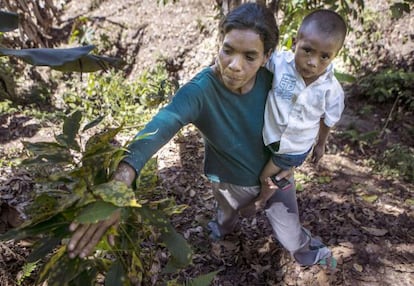US fears coffee rust disease may destabilize Central America
More than 500,000 jobs could be lost in coming years if plague is not contained, says USAID

The worst bout of coffee rust disease in nearly 40 years has already caused millions of dollars of losses in Central America, whose foreign economy depends largely on coffee exports.
The effects of this plant fungus on regional production have raised the alarm in the United States, which fears that the loss of jobs could undermine regional stability, increase insecurity and drive up migratory flows.
The US Agency for International Development (USAID) on Monday announced a $5-million partnership with Texas A&M University’s World Coffee Research to try to contain the plague.
Coffee rust has already spread throughout thousands of hectares of cultivated land in Central America, turning plants orange and yellow and threatening jobs across the production and sales chain.
If the problem persists, it will have an impact on immigration patterns
Figures released by the US State Department show that Central America, southern Mexico and the Caribbean “are experiencing the worst outbreak of coffee rust since it first emerged in 1976.”
Since 2012, the yellow fungus has attacked more than half of the 933,000 hectares of land devoted to coffee crops in Central America, causing huge economic losses in a region where over 50 percent of its 43.7 million inhabitants live in poverty and where coffee is a historical export product.
The International Coffee Organization reports that the epidemic could eliminate as many as 374,000 direct jobs. For this new crop cycle, the agency is forecasting a new drop of eight percent, for a total of 16.5 million bags. Ric Rhinehart, spokesman for the Specialty Coffee Association of America, explains that the fungus had been confined to low altitudes, “but due to a combination of higher temperatures and rain patterns it advanced to higher places, and farmers were not ready for that.
“In the short term, part of the solution is to increase access to fungicides by smallholder farmers; later, more effective handling techniques must be found, as well as data allowing the development of more resistant plants,” adds Rhinehart.
Higher temperatures and rain saw it advance higher, and farmers were not ready for that”
According to Mark Feierstein, associate administrator at USAID, the American government has invested $14 million in the fight against coffee rust in Latin America, including $5 million recently announced.
“We want to work on projects such as resistant plantations and the possibility of preventing outbreaks. We know it will take time to deal with this,” he says.
If the problem persists, adds Feierstein, it will have an impact on immigration pattens from rural areas to urban areas and toward the US.
This agency also estimates that if progress is not made soon, coffee production in the region could fall between 15 and 40 percent in the coming years, with more than 500,000 job losses. “Another effect is the vulnerability of these people to organized crime gangs present in the area,” adds Feierstein.
Tu suscripción se está usando en otro dispositivo
¿Quieres añadir otro usuario a tu suscripción?
Si continúas leyendo en este dispositivo, no se podrá leer en el otro.
FlechaTu suscripción se está usando en otro dispositivo y solo puedes acceder a EL PAÍS desde un dispositivo a la vez.
Si quieres compartir tu cuenta, cambia tu suscripción a la modalidad Premium, así podrás añadir otro usuario. Cada uno accederá con su propia cuenta de email, lo que os permitirá personalizar vuestra experiencia en EL PAÍS.
¿Tienes una suscripción de empresa? Accede aquí para contratar más cuentas.
En el caso de no saber quién está usando tu cuenta, te recomendamos cambiar tu contraseña aquí.
Si decides continuar compartiendo tu cuenta, este mensaje se mostrará en tu dispositivo y en el de la otra persona que está usando tu cuenta de forma indefinida, afectando a tu experiencia de lectura. Puedes consultar aquí los términos y condiciones de la suscripción digital.
Últimas noticias
From digital curfews to blocking apps: How technology experts protect their children online
Why the price of coffee has skyrocketed: from Brazilian plantations to specialty coffee houses
Confined to a Cuban hospital: When electricity is a matter of life or death
The complicated life of Francesca Albanese: A rising figure in Italy but barred from every bank by Trump’s sanctions
Most viewed
- Why we lost the habit of sleeping in two segments and how that changed our sense of time
- Pablo Escobar’s hippos: A serious environmental problem, 40 years on
- Trump’s obsession with putting his name on everything is unprecedented in the United States
- The Florida Keys tourist paradise is besieged by immigration agents: ‘We’ve never seen anything like this’
- Charles Dubouloz, mountaineering star, retires at 36 with a farewell tour inspired by Walter Bonatti








































